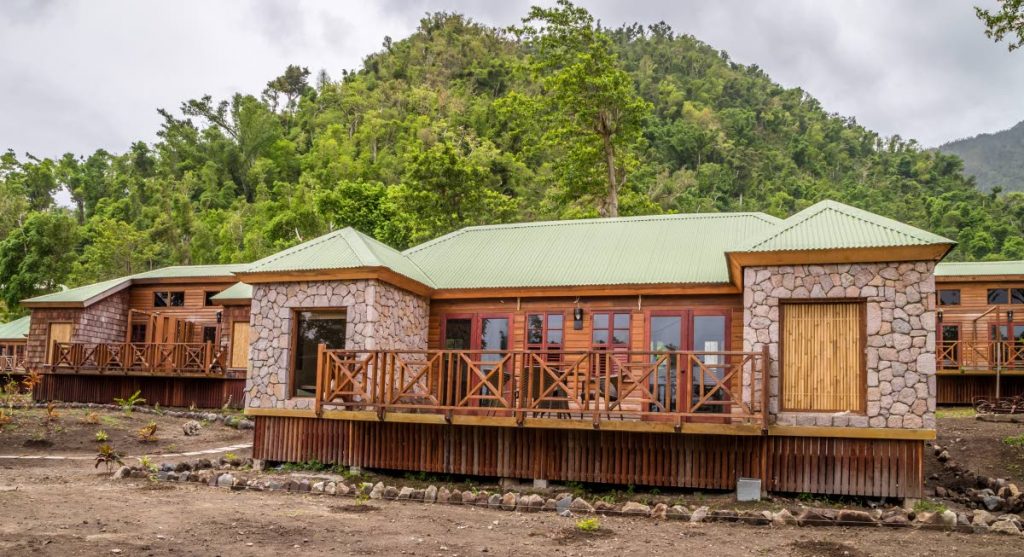Dominica, hurricane strong

At first glance, it’s hard to believe that just two years ago, downtown Roseau – Dominica’s capital city – was littered in debris from houses, buildings and trees after hurricanes Maria and Irma devastated the island in quick succession with only two months between them.
Just two years before, the island faced-off against Tropical Storm Erika, which had then been the most destructive natural disaster in Dominica since Hurricane David in 1949.
Today, Roseau is an up and coming tiny metropolis, teeming with life as many of the island's commercial crops and industries have returned, bringing a sense of hope among its people. Key for this near-miraculous turnaround is a fundamental emphasis on climate resilience, including hurricane proofing infrastructure.

Newsday visited the island on June 13, 2019 as part of efforts from Dominica’s tourism and environment ministries to give a clearer picture on how much the country has progressed from the devastation.
Dominica is 700 square kilometres – a little more than twice the size of Tobago – and is located in the middle of the Caribbean’s hurricane belt. This leaves the island vulnerable to hurricanes, a potential disincentive to foreign investors interested in capitalising from the eco-tourism industry in the “nature isle.”
A report issued by the Assessment Capacities Project in Switzerland, last January, placed damage to Dominica’s economy at approximately US$930 million, with the housing sector sustaining most of the damage. Damage from Erika, two years before, cost the country an estimated US$500 million. In contrast, Dominica's GDP in 2017 according to the World Bank was US$497 million.

Last year, Prime Minister Roosevelt Skerrit announced the government’s mandate to build 5,000 new homes for people displaced from Hurricane Maria, as part of Dominica’s new “housing revolution.” He also proclaimed that Dominica would be the world’s first climate resilient nation.
Speaking with Newsday at his Roseau office last Friday, Minister of the Environment, Climate Resilience and Urban Renewal Joseph Isaac said the new housing complexes featured the latest methods in hurricane-proofing, including material. He was confident that the government and its people were prepared for this year’s hurricane season.
“The housing revolution really consisted of us redesigning our houses and buildings and if you go to the different places in the Soufriere area, you will see the housing programmes have new designs where not even a category five hurricane would significantly impact it.”

Among the innovations, utility lines are underground and infrastructure is constructed using reinforced concrete and where applicable, hurricane-impact glass. “If the experience has taught us something, it is that in preparation, we need to build with resilience in mind.”
Isaac said the target of the revolution was those 5,000 new homes for Dominicans, particularly those whose homes were destroyed after the hurricanes.
While the threat of hurricane winds was a serious concern in designing the homes, damage from flooding and storm surge for coastal properties was also considered in planning and development, something he said was mitigated by constructing coastal walls.
While Dominica had long been interested in creating a new wave of affordable homes for its citizens, the devastation left by the hurricanes was the catalyst.
Financing by the people
The initiative is financed by Dominica’s Citizenship by Investment (CBI) programme, where citizens have the opportunity to invest in various government development projects.
The programme seeks to attract people (foreign nationals) interested in investing in Dominica by contributing to a particular project. They receive citizenship in return.
Asked how much money has been invested in the housing project, Isaac said he did not have that information available. Last October, however, Skerrit announced an estimated £155 million was to be invested into the project.
Green rebound
After the hurricanes, foliage has returned, including most of the island’s commercial crops like bayleaf, bananas and coconuts. With the exception of a few coconut trees, whose canopies were torn off from the winds, there are few reminders of the devastation that happened.
Isaac said in addition to developing more resilient construction, government, through his ministry has also sought to find a more environmentally-friendly means of hurricane-proofing the island – an aggressive tree-planting campaign featuring trees that can be resistant to hurricane-force winds. Among the species being planted are avocado, soursop, carambolas, cashews, cocoa, coffee, mangoes, guavas and cherries.
Private sector not waiting
While this increased campaign to better house and secure its citizens is welcome, private investors are not waiting for the government to catch up and have taken the necessary precautions to strengthen and secure their businesses against hurricanes – something they started doing well before Maria’s impact.
Alicia Paige-Davison, owner of the Pagua Bay Guesthouse in Marigot, northeastern Dominica, said before moving to the island 14 years ago, she lived in Miami and was aware first hand of how damaging hurricanes can be.
In anticipation of that she built the resort using guidelines from the Miami-Dade construction code, a precaution she says paid off after Maria when the resort was relatively untouched.
“We used a lot of concrete. That, along with the rock wall near the pool, helped to (buffer against) some of the wind. The only damage we had was part of the overhang from our roof blew over some of our suites and we built it separate from the rooftop, so we didn’t have much other damage.”

Speaking with Newsday via email, eco-tourism consultant for the Jungle Bay Resort and Spa, Laura Ell said while the resort was not affected during Maria, management has taken steps to ensure the safety of its guests.
“Some examples of the building design to mitigate future weather events include strategic infrastructure placement based on the landscape and use of steel-reinforced concrete and stone building materials, making the villas and guest facilities stronger while still having a beautiful architectural look. We also used robust fasteners to secure roofs and window design to allow airflow,” Ell said.
There is always hope
While there is no guaranteed way to secure and protect property during times of disaster, both the government and private sector seem keen on developing a more robust means of protecting its citizens, its investors and their future.
Days after seeing his country through the horror of Maria, Skerrit spoke at the United Nations General Assembly. In an impassioned speech, he called for immediate action on climate change, imploring the rest of the world to help the Caribbean region, victims of a war against nature they did not start. He urged aid and financing accessible to small island developing states to help rebuild from the devastation. He also preached hope.
“Let these extraordinary events, elicit extraordinary efforts, to rebuild nations sustainably. Let these extraordinary events unleash the innovation and creativity of global citizens to spark a new paradigm of green economic development that stabilises and reverses the consequences of human-induced global warming. Let it spark a thousand points of light, not shame. Let us take serious action against the realities of climate change.

"We are in shock, but we are not stooped! We cry; but do not despair. We will rise. Because Dominican people are strong. Because Caribbean people are resilient. We will rebuild our garden of Eden again, for our children and for future generations.”
Suggested Sidebar NB the quarry photo should go close to or with the sidebar
Mining to build
Compared to tourism and agriculture, mining makes a relatively small contribution to Dominica's economy.
Beginning in 1997, pumice was the major commodity extracted from the island for export, and Dominica produced clay, limestone, volcanic ash, and sand and gravel, primarily for the construction industry.
Between 2013 to 2015, the contribution to the economy from mining has decreased from 1.04 per cent to 0.84 per cent.
In 2009, there were concerns over the proximity of homes to one of the largest quarries in Colihaut, northern Dominica.
On the trip, a crew from Carib Sand and Stone Ltd was grading a hillside at a quarry in Roseau, and uses the material to manufacture quality aggregate products for local and export markets


Comments
"Dominica, hurricane strong"